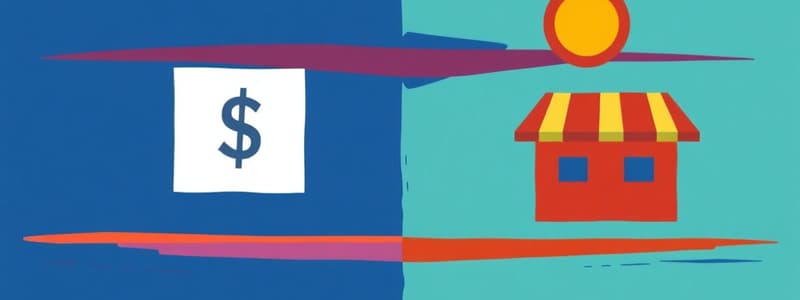Podcast
Questions and Answers
What is derived demand?
What is derived demand?
- The demand for luxury goods irrespective of their utility.
- The demand for goods and services that are used to produce other goods or services. (correct)
- The demand for essential services that remain constant regardless of price changes.
- The demand for goods that are only desired for their own sake.
Which statement accurately describes the law of demand?
Which statement accurately describes the law of demand?
- The quantity demanded increases as the price increases.
- As price decreases, the quantity demanded increases, all else being equal. (correct)
- There is no relationship between price and quantity demanded.
- The quantity demanded remains constant even with price changes.
What does a demand schedule represent?
What does a demand schedule represent?
- It outlines the total consumer spending at a fixed price.
- It illustrates consumer preferences for different products over time.
- It shows the relationship between price and consumer income.
- It displays the various quantities demanded at different price levels. (correct)
What is one reason consumers may rush to buy a good despite constant prices?
What is one reason consumers may rush to buy a good despite constant prices?
Which of the following describes Giffen goods?
Which of the following describes Giffen goods?
What happens to marginal utility as total consumption increases according to the law of diminishing marginal utility?
What happens to marginal utility as total consumption increases according to the law of diminishing marginal utility?
When does a consumer reach utility maximization or consumer equilibrium?
When does a consumer reach utility maximization or consumer equilibrium?
Which of the following is NOT an assumption of the indifference curve theory?
Which of the following is NOT an assumption of the indifference curve theory?
What characteristic describes the slope of an indifference curve?
What characteristic describes the slope of an indifference curve?
According to the theory of consumer behavior, what must hold true about the marginal utility of commodity X?
According to the theory of consumer behavior, what must hold true about the marginal utility of commodity X?
Which axiom states that consumers must be consistent in their choices?
Which axiom states that consumers must be consistent in their choices?
What conclusion can be drawn when an indifference curve intersects with another?
What conclusion can be drawn when an indifference curve intersects with another?
Which of the following statements about utility maximization is correct?
Which of the following statements about utility maximization is correct?
What does the average product of labor (APL) signify?
What does the average product of labor (APL) signify?
Which statement accurately reflects the law of diminishing marginal returns?
Which statement accurately reflects the law of diminishing marginal returns?
If a firm has a total cost (TC) of 150 at output level 5, what is the average cost (AC)?
If a firm has a total cost (TC) of 150 at output level 5, what is the average cost (AC)?
How is marginal cost (MC) defined in production?
How is marginal cost (MC) defined in production?
At which labor level does the average product of labor decrease drastically?
At which labor level does the average product of labor decrease drastically?
Which of the following best defines money in an economic context?
Which of the following best defines money in an economic context?
What does total production refer to?
What does total production refer to?
If the marginal product of labor (MPL) becomes negative, what is the implication about labor usage?
If the marginal product of labor (MPL) becomes negative, what is the implication about labor usage?
What does it mean when the price elasticity of demand (Ep) is equal to infinity?
What does it mean when the price elasticity of demand (Ep) is equal to infinity?
Which of the following determinants of elasticity of demand indicates how quickly consumers can adjust to price changes?
Which of the following determinants of elasticity of demand indicates how quickly consumers can adjust to price changes?
What is the characteristic of land that indicates it cannot be easily moved to different locations?
What is the characteristic of land that indicates it cannot be easily moved to different locations?
What type of demand elasticity has a negative value for inferior goods?
What type of demand elasticity has a negative value for inferior goods?
When the cross elasticity of demand is positive, what does this imply about the goods involved?
When the cross elasticity of demand is positive, what does this imply about the goods involved?
What is a key aspect of labour as a factor of production?
What is a key aspect of labour as a factor of production?
Which of the following statements accurately describes unitary elasticity?
Which of the following statements accurately describes unitary elasticity?
What reward is associated with the factor of production known as land?
What reward is associated with the factor of production known as land?
What is the primary objective of a commercial bank?
What is the primary objective of a commercial bank?
Which of the following is not a function of the central bank?
Which of the following is not a function of the central bank?
What distinguishes the money market from the capital market?
What distinguishes the money market from the capital market?
Which factor is not a reason for engaging in international trade?
Which factor is not a reason for engaging in international trade?
According to the theory of absolute advantage, a country should specialize in production when:
According to the theory of absolute advantage, a country should specialize in production when:
Which statement accurately describes balance of payments (BOP)?
Which statement accurately describes balance of payments (BOP)?
What does the term 'terms of trade' refer to?
What does the term 'terms of trade' refer to?
Which of the following represents a negative impact of international trade?
Which of the following represents a negative impact of international trade?
Flashcards are hidden until you start studying
Study Notes
Economic Concepts and Calculations
- Total Cost (TC), Average Cost (AC), and Marginal Cost (MC) are critical in understanding production economics.
- Marginal product of labor (MPL) represents the additional output resulting from one more unit of labor, demonstrating diminishing returns as more labor is added.
- Law of Diminishing Marginal Returns indicates that initially, total output increases but eventually declines with continued addition of a variable factor to a fixed factor.
Money and Demand
- Money is a scarce resource, fixed in price, generally accepted for settling debts or purchasing goods and services.
- Trade by barter involves direct exchange of goods and services, which is less efficient than using money.
- Derived demand refers to demand for goods and services based on their use for producing other goods.
- Law of Demand states that lower prices lead to higher quantity demanded, and vice versa, following a demand schedule and represented graphically as a downward-sloping demand curve.
Exceptions to the Law of Demand
- Inferior goods: Demand decreases with increase in consumer income.
- Giffen goods: Demand paradoxically increases as prices rise due to reliance on more affordable substitutes.
- Luxurious goods: Demand may increase as wealthier consumers buy for ostentation.
- Anticipated future price rises can cause current demand spikes even without price change.
Utility and Consumer Behavior
- Law of Diminishing Marginal Utility posits that satisfaction decreases with each additional unit consumed; the greater the consumption, the lower the satisfaction derived.
- Consumer equilibrium occurs when the marginal utility of a good equals its price, leading to optimal purchasing decisions.
Indifference Curve Analysis
- Indifference curves represent combinations of goods providing equal satisfaction, with key assumptions such as rationality and diminishing marginal rates of substitution.
- Characteristics include curves being negatively sloped, convex to the origin, and not intersecting.
Elasticity of Demand
- Price elasticity of demand (Ep) measures responsiveness of quantity demanded to price changes, with specific categorizations: perfectly elastic, elastic, unitary, inelastic.
- Arc elasticity calculates elasticity between two points to understand shifts in demand.
- Determinants include availability of substitutes, product expenditure, time, necessity, habits, and supply proportions.
Production Theory
- Production involves creating wealth and utility, relying on factors such as land, labor, capital, and entrepreneurship.
- Characteristics of land include being fixed in supply, varying in quality, and yielding rent as reward.
- Labor involves human effort and is subject to ethical considerations, with limited quantities and perishability.
Banking and Financial Markets
- Commercial banks focus on profit through handling money and credit, offering services such as deposits, loans, foreign exchange, and bill discounting.
- Central banks operate under government ownership, manage currency, and oversee monetary policy to stabilize the economy.
- Capital markets facilitate long-term borrowing and lending, while money markets deal with short-term funds.
International Trade
- Trade involves exchanges within and outside countries, with domestic trade occurring locally and international trade across borders.
- Reasons for international trade include resource availability, climate differences, capital possession, and technological advantages.
- Theory of Absolute Advantage suggests countries specialize in commodities they can produce most efficiently, while Comparative Advantage advocates trading even when a nation is better at producing both goods.
- Balance of Payment (BOP) chronicles international transactions, revealing trade surpluses (receipts exceed payments) or deficits (payments exceed receipts).
Studying That Suits You
Use AI to generate personalized quizzes and flashcards to suit your learning preferences.




